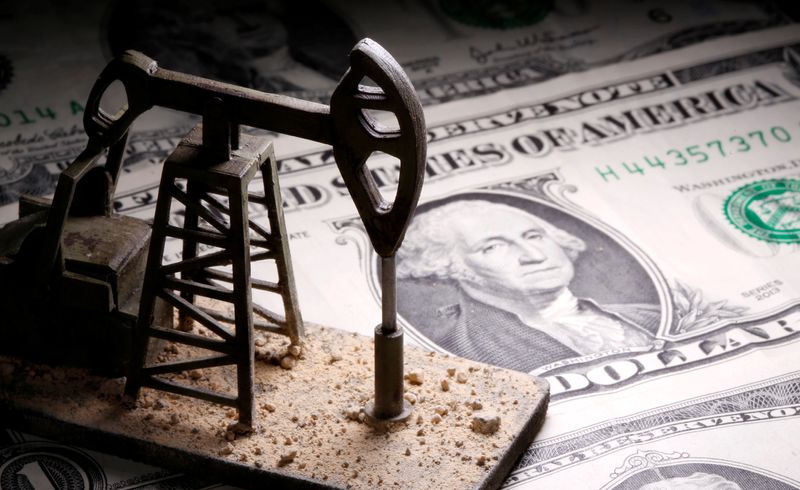Commodities
Oil edges up as investors eye Middle East tensions and US rate cut


© Reuters. A 3D printed oil pump jack is placed on dollar banknotes in this illustration picture, April 14, 2020. REUTERS/Dado Ruvic/Illustration/file photo
By Alex Lawler
LONDON (Reuters) -Oil edged higher on Tuesday, finding support from geopolitical tensions in the Middle East and investor optimism that the U.S. Federal Reserve would soon start cutting interest rates, boosting global economic growth and fuel demand.
While hopes of rate cuts and conflict in the Red Sea have led to a rebound in crude prices, Maersk’s announcement of a restart of shipping routes through the waterway has alleviated supply concerns to a certain extent, said CMC Market analyst Leon Li.
futures rose 18 cents, or 0.2%, to $79.25 a barrel by 1208 GMT while U.S. West Texas Intermediate crude was up 3 cents at $73.59.
“The lack of oil supply disruptions is offsetting the support to prices from ongoing geopolitical tensions in the Middle East,” said UBS analyst Giovanni Staunovo, adding that trade was thin and in a narrow range typical of holiday periods.
Volume is light because some markets are closed for public holidays.
Both oil benchmarks registered gains of about 3% last week after Houthi attacks on ships disrupted global shipping and trade while the Israel-Hamas conflict shows no sign of easing.
Shipping companies had stopped sending vessels through the Red Sea and imposed surcharges for re-routing ships. The Red Sea connects with the Suez Canal, a major shipping route used for about 12% of global trade.
Maersk’s statement on Sunday cited deployment of a US-led military operation designed to ensure the safety of commerce in the area.
Germany’s Hapag-Lloyd will decide on Wednesday how it will proceed with its Red Sea routes after suspending shipments there, a spokesperson said on Tuesday.
Two explosions in the Red Sea were reported by a vessel sailing off the coast of Yemen on Tuesday shortly after two unmanned aircraft were sighted, a British maritime authority said.
Oil also found support from expectations that the Fed wil cut interest rates next year. Lower interest rates cut consumer borrowing costs, which can boost economic growth and oil demand.
Commodities
Oil prices rise; U.S. crude inventories plunge, Russia-Ukraine truce eyed
Commodities
India’s Reliance to stop buying Venezuelan oil over US tariffs, sources say
Commodities
Oil prices climb on Venezuela supply worries

 Forex3 years ago
Forex3 years agoForex Today: the dollar is gaining strength amid gloomy sentiment at the start of the Fed’s week

 Forex3 years ago
Forex3 years agoUnbiased review of Pocket Option broker

 Forex3 years ago
Forex3 years agoDollar to pound sterling exchange rate today: Pound plummeted to its lowest since 1985

 Forex3 years ago
Forex3 years agoHow is the Australian dollar doing today?

 Cryptocurrency3 years ago
Cryptocurrency3 years agoWhat happened in the crypto market – current events today

 World3 years ago
World3 years agoWhy are modern video games an art form?

 Commodities3 years ago
Commodities3 years agoCopper continues to fall in price on expectations of lower demand in China

 Economy3 years ago
Economy3 years agoCrude oil tankers double in price due to EU anti-Russian sanctions























